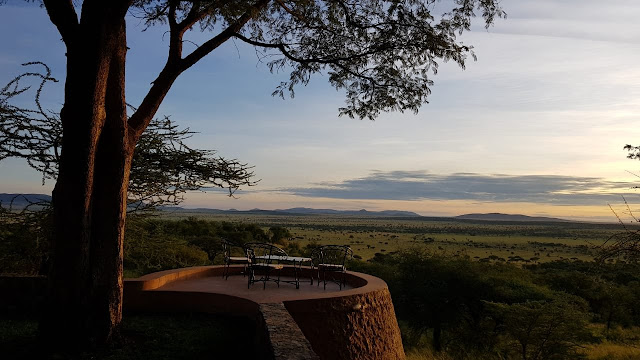Serengeti National Park is a Tanzanian national park
in the Serengeti ecosystem in the Mara and Simiyu regions.
It was first established in
the 1920’s and was made a National Park in 1951.
The park covers 14,750 square kilometers (10 times
bigger than Masai Mara) of grassland plains, savanna, riverine forest, and
woodlands.
With elevations ranging from 3,000 to 6,500
feet.
Great herds of buffalo, smaller groups of elephant
and giraffe, and thousands upon thousands of Antelops like eland,
topi, kongoni, impala and Grant’s gazelle are resident at any
time of the year.
All three big cats are easily seen. Lions are
everywhere and are often found on a kill. Cheetahs are very common on the
southeastern plains, while leopards can often be found lazing in one
of the big trees along the Seronera River.
There are many more animals in Serengeti National Park
including: hippos, rhinos,
hynas, jackals, wild dogs, 10 species of
primate and Nile crocodiles…
And a million wildebeest…
The Serengeti is famed for its annual wildebeest
migration, when some six million hooves cross the open plains,
as more than 1,000,000
wildebeest, 200,000 zebra and 300,000 Thomson’s
gazelle join the trek for fresh grazing.
The annual migration is one of the most impressive natural
events in the world.
About 250,000 wildebeest die during the journey usually
from thirst, hunger, exhaustion, or predation.
The Park also hosts one of the largest and most
diverse large predator-prey interactions worldwide, providing a
particularly impressive aesthetic experience.
The park also boasts about 500 bird species,
including ostrich, secretary bird, kori bustard, crowned crane,
marabou stork, martial eagle, lovebirds, and many species of vultures.
The park is usually described as divided into three
regions: Serengeti plains, Western corridor and
Northern Serengeti.
Serengeti plains: the almost treeless grassland of the south
is the most emblematic scenery of the park. This is where the wildebeest breed,
as they remain in the plains from December to May. Other hoofed animals
– zebra, gazelle, impala,
hartebeest, topi, buffalo, waterbuck – also occur in huge
numbers during the wet season.
Serengeti plains is dotted with a number of granite and
gneiss outcroppings known as kopjes, which are large rocky formations that
are the result of volcanic activity and they are great observation posts for
predators, as well as a refuge for hyrax and pythons.
Western corridor: the black clay soil covers the swampy
savannah of this region. The Grumeti River is home to Nile crocodiles, colobus
monkeys, hippopotamus, and martial eagles. The migration passes through from
May to July.
Northern Serengeti: the landscape is dominated by open
woodlands and hills, ranging from Seronera in the south to the Mara River on
the Kenyan border. Apart from the migratory wildebeest and zebra (which occur
from July to August, and in November), the bushy savannah is the best place to
find elephant and giraffe.
The usually warm and dry climate is interrupted by
two rainy seasons — Feb to Aprik, and a shorter season in October and
November.
Because of its biodiversity and ecological significance, the
park has been listed as a UNESCO World
Heritage Site.
Serengeti National Park is at the heart the
larger Serengeti ecosystem, which is defined by the area covered by the
annual migration.
The Maasai people had been grazing their livestock
in the open plains of eastern Mara Region, which they named “endless plains”,
for around 200 years when the first European explorer, Austrian Oscar Baumann,
visited the area in 1892.
The name “Serengeti” is an approximation of the
word used by the Maasai to describe the area, siringet, which means “the place
where the land runs on forever.”
The Serengeti offers great wildlife viewing throughout
the year. July, Aug good for seeing the
migration and February is the best month for the wildebeest calving. The dry
months from May to October offer the best general game viewing.
More than 90,000 people from around the world
visit the park every year.









No comments:
Post a Comment